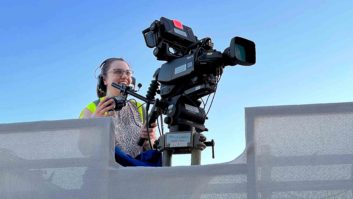
As UAVs continue to rapidly evolve they will impact more conventional video and movie production devices and techniques, says Ram Ofir, president & CEO, Amimon
From Amimon’s perspective the broadcast industry has made a very rapid change with the swift advent of new drone technology and hardware, both of which are the prime drivers for the business right now.
The global UAV/drone market continues to change dramatically as a result of two core drivers: 1) New technologies that deliver high performance drone/UAV capabilities at a wide range of price points; 2) The increased demand for UAV/drones from entrepreneurs, enthusiasts, consumers and professional users. The latter driven by the potential for UAV/drones to help professionals generate new sources of revenue in myriad vertical markets such as the broadcast and commercial production arenas, and as a new creative and cost-efficient platform for video capture and production.
On the new technology front, there are the UAV/drones themselves which continue to deliver better in-flight performance, and are now offered in a multitude of models and styles to accommodate a very broad range of applications and price points. Then there are the tools that enable advanced video capture such as new gimbals and image capture devices, as well as innovative video transmission solutions like CONNEX from Amimon that enables realtime transmission of full stream HD video over extended distances.
As UAV/drones continue to rapidly evolve, they will continue to impact more conventional video and movie production devices and techniques. For example, UAV/drones equipped with new lightweight HD cameras mounted on remotely controlled gimbals deliver far superior mobility and performance than traditional camera dollies. UAV/drones enable innovative and exciting camera angles by literally freeing cameras from being tethered to large bulky devices, and mobilising them on an aerial platform that can be deployed almost anywhere with little effort.
These same benefits apply to using UAV/drones in lieu of camera cranes and helicopters with camera pads. Once again, UAV/drones are not just replacing these devices, they are providing a new and better platform to create more engaging visual content.
For broadcast applications, UAV/drones deliver a significant breakthrough in newsgathering capabilities. One conventional ENG vehicle can be replaced by several UAV/drones equipped with HD cameras and realtime transmission solutions enabling multiple news crews in conventional automobiles (even compact cars) to dramatically increase a news coverage.
For movie and commercial video production, shots can be accomplished almost anywhere without the need to deploy expensive and bulky camera support equipment – and UAV/drones can be used in remote or difficult locations where traditional camera support devices simply can’t be deployed. The possibilities are almost limitless and open up a whole new world of creative opportunities.
This year at IBC, visitors can expect to see a heightened presence of UAV/drone technologies on display with live demonstrations and testimonials as to how these solutions are changing the broadcast and production industries. In fact, I think many IBC attendees will be surprised at the level of exposure for UAV/drones as we witnessed firsthand at NAB earlier this year.
11.C75







